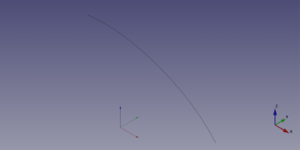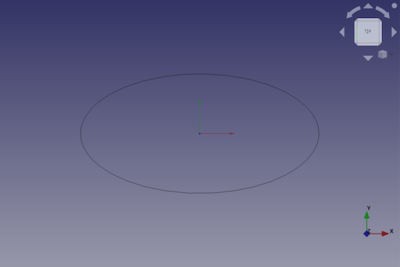Part Ellipse: Difference between revisions
(Revising...) |
(Marked this version for translation) |
||
| (4 intermediate revisions by the same user not shown) | |||
| Line 1: | Line 1: | ||
<languages/> |
<languages/> |
||
{{UnfinishedDocu{{#translation:}}}} |
|||
<translate> |
<translate> |
||
| Line 24: | Line 23: | ||
<!--T:5--> |
<!--T:5--> |
||
A [[Image:Part_Ellipse.svg|24px]] Part Ellipse is a parametric shape that can be created with the [[Image:Part_Primitives.svg|24px]] [[Part_Primitives|Part Primitives]] command. In the coordinate system defined by its {{PropertyData|Placement}} property, the ellipse lies on the XY plane with its center at the origin. Its mayor axis is parallel to the X axis. |
A [[Image:Part_Ellipse.svg|24px]] '''Part Ellipse''' is a parametric shape that can be created with the [[Image:Part_Primitives.svg|24px]] [[Part_Primitives|Part Primitives]] command. In the coordinate system defined by its {{PropertyData|Placement}} property, the ellipse lies on the XY plane with its center at the origin. Its mayor axis is parallel to the X axis. |
||
<!--T:10--> |
|||
A Part Ellipse is in fact a closed counterclockwise elliptical arc, it can be turned into an arc by changing its {{PropertyData|Angle1}} and/or {{PropertyData|Angle2}} properties. |
A Part Ellipse is in fact a closed counterclockwise elliptical arc, it can be turned into an arc by changing its {{PropertyData|Angle1}} and/or {{PropertyData|Angle2}} properties. |
||
| Line 34: | Line 34: | ||
== Usage == <!--T:7--> |
== Usage == <!--T:7--> |
||
<!--T:11--> |
|||
See [[Part_Primitives#Usage|Part Primitives]]. |
See [[Part_Primitives#Usage|Part Primitives]]. |
||
== Example == |
== Example == <!--T:12--> |
||
<!--T:13--> |
|||
[[Image:Part_Ellipse_Scripting_Example.png|thumb|Part Ellipse from the scripting example]] |
[[Image:Part_Ellipse_Scripting_Example.png|thumb|Part Ellipse from the scripting example]] |
||
<!--T:14--> |
|||
A Part Ellipse object created with the [[#Scripting|scripting example]] below is shown here. |
A Part Ellipse object created with the [[#Scripting|scripting example]] below is shown here. |
||
== Properties == |
== Properties == <!--T:15--> |
||
<!--T:16--> |
|||
See also: [[Property_editor|Property editor]]. |
See also: [[Property_editor|Property editor]]. |
||
<!--T:17--> |
|||
A Part Ellipse object is derived from a [[Part_Feature|Part Feature]] object and inherits all its properties. It also has the following additional properties: |
A Part Ellipse object is derived from a [[Part_Feature|Part Feature]] object and inherits all its properties. It also has the following additional properties: |
||
=== Data === |
=== Data === <!--T:18--> |
||
<!--T:19--> |
|||
{{TitleProperty|Attachment}} |
|||
<!--T:20--> |
|||
The object has the same attachment properties as a [[Part_Part2DObject#Data|Part Part2DObject]]. |
|||
<!--T:21--> |
|||
{{TitleProperty|Base}} |
{{TitleProperty|Base}} |
||
<!--T:22--> |
|||
* {{PropertyData|MajorRadius|Length}}: The major radius of the ellipse. This is the dimension in the x-direction. |
|||
* {{PropertyData| |
* {{PropertyData|MajorRadius|Length}}: The major radius of the ellipse or elliptical arc. The default is {{Value|4mm}}. |
||
* {{PropertyData| |
* {{PropertyData|MinorRadius|Length}}: The minor radius of the ellipse or elliptical arc. The default is {{Value|2mm}}. |
||
* {{PropertyData| |
* {{PropertyData|Angle1|Angle}}: The start angle of the elliptical arc. Valid range: {{Value|0° < value <= 360°}}. The default is {{Value|0°}}. |
||
* {{PropertyData|Angle2|Angle}}: The end angle of the elliptical arc. Valid range: {{Value|0° < value <= 360°}}. The default is {{Value|360°}}. If {{PropertyData|Angle1}} and {{PropertyData|Angle2}} are equal, or if one angle is {{Value|0°}} and the other {{Value|360°}}, a full ellipse is created. |
|||
== Scripting == |
== Scripting == <!--T:23--> |
||
<!--T:24--> |
|||
| ⚫ | |||
See also: [https://freecad.github.io/SourceDoc/ Autogenerated API documentation], [[Part_scripting|Part scripting]] and [[FreeCAD_Scripting_Basics|FreeCAD Scripting Basics]]. |
|||
<!--T:25--> |
|||
| ⚫ | |||
</translate> |
</translate> |
||
| Line 67: | Line 84: | ||
<translate> |
<translate> |
||
<!--T:26--> |
|||
* Where {{Incode|myEllipse}} is the name for the object |
* Where {{Incode|"myEllipse"}} is the name for the object. |
||
* The function returns the newly created object. |
* The function returns the newly created object. |
||
<!--T:27--> |
|||
The {{Incode|Label}} is the user editable name for the object. It can be easily changed by |
|||
Example: |
|||
</translate> |
</translate> |
||
{{Code|code= |
{{Code|code= |
||
import FreeCAD as App |
|||
ellipse.label = "new ellipseName" |
|||
}} |
|||
<translate> |
|||
doc = App.activeDocument() |
|||
You can access and modify attributes of the {{Incode|ellipse}} object. For example, you may wish to modify the two radii and angles of the ellipse. |
|||
ellipse = doc.addObject("Part::Ellipse", "myEllipse") |
|||
</translate> |
|||
{{Code|code= |
|||
ellipse.MajorRadius = 20 |
ellipse.MajorRadius = 20 |
||
ellipse.MinorRadius = 10 |
ellipse.MinorRadius = 10 |
||
ellipse.Angle1 = 45 |
ellipse.Angle1 = 45 |
||
ellipse.Angle2 = 135 |
ellipse.Angle2 = 135 |
||
| ⚫ | |||
doc.recompute() |
|||
}} |
}} |
||
<translate> |
<translate> |
||
The result will be a part of an ellipse. |
|||
You can change its placement and orientation with: |
|||
</translate> |
|||
{{Code|code= |
|||
| ⚫ | |||
}} |
|||
<translate> |
|||
<!--T:9--> |
<!--T:9--> |
||
| Line 110: | Line 120: | ||
</translate> |
</translate> |
||
{{ |
{{Part_Tools_navi{{#translation:}}}} |
||
{{Userdocnavi{{#translation:}}}} |
{{Userdocnavi{{#translation:}}}} |
||
Latest revision as of 10:25, 3 March 2022
|
|
| Menu location |
|---|
| Part → Create primitives → Ellipse |
| Workbenches |
| Part, OpenSCAD |
| Default shortcut |
| None |
| Introduced in version |
| - |
| See also |
| Part Primitives |
Description
A Part Ellipse is a parametric shape that can be created with the
Part Primitives command. In the coordinate system defined by its DataPlacement property, the ellipse lies on the XY plane with its center at the origin. Its mayor axis is parallel to the X axis.
A Part Ellipse is in fact a closed counterclockwise elliptical arc, it can be turned into an arc by changing its DataAngle1 and/or DataAngle2 properties.
Usage
See Part Primitives.
Example

A Part Ellipse object created with the scripting example below is shown here.
Properties
See also: Property editor.
A Part Ellipse object is derived from a Part Feature object and inherits all its properties. It also has the following additional properties:
Data
Attachment
The object has the same attachment properties as a Part Part2DObject.
Base
- DataMajorRadius (
Length): The major radius of the ellipse or elliptical arc. The default is4mm. - DataMinorRadius (
Length): The minor radius of the ellipse or elliptical arc. The default is2mm. - DataAngle1 (
Angle): The start angle of the elliptical arc. Valid range:0° < value <= 360°. The default is0°. - DataAngle2 (
Angle): The end angle of the elliptical arc. Valid range:0° < value <= 360°. The default is360°. If DataAngle1 and DataAngle2 are equal, or if one angle is0°and the other360°, a full ellipse is created.
Scripting
See also: Autogenerated API documentation, Part scripting and FreeCAD Scripting Basics.
A Part Ellipse can be created with the addObject() method of the document:
ellipse = FreeCAD.ActiveDocument.addObject("Part::Ellipse", "myEllipse")
- Where
"myEllipse"is the name for the object. - The function returns the newly created object.
Example:
import FreeCAD as App
doc = App.activeDocument()
ellipse = doc.addObject("Part::Ellipse", "myEllipse")
ellipse.MajorRadius = 20
ellipse.MinorRadius = 10
ellipse.Angle1 = 45
ellipse.Angle2 = 135
ellipse.Placement = App.Placement(App.Vector(1, 2, 3), App.Rotation(30, 45, 10))
doc.recompute()
- Primitives: Box, Cylinder, Sphere, Cone, Torus, Tube, Create primitives, Shape builder
- Creation and modification: Extrude, Revolve, Mirror, Fillet, Chamfer, Make face from wires, Ruled Surface, Loft, Sweep, Section, Cross sections, 3D Offset, 2D Offset, Thickness, Projection on surface, Attachment
- Boolean: Make compound, Explode Compound, Compound Filter, Boolean, Cut, Fuse, Common, Connect, Embed, Cutout, Boolean fragments, Slice apart, Slice, XOR
- Measure: Measure Linear, Measure Angular, Measure Refresh, Clear All, Toggle All, Toggle 3D, Toggle Delta
- Getting started
- Installation: Download, Windows, Linux, Mac, Additional components, Docker, AppImage, Ubuntu Snap
- Basics: About FreeCAD, Interface, Mouse navigation, Selection methods, Object name, Preferences, Workbenches, Document structure, Properties, Help FreeCAD, Donate
- Help: Tutorials, Video tutorials
- Workbenches: Std Base, Arch, Assembly, CAM, Draft, FEM, Inspection, Mesh, OpenSCAD, Part, PartDesign, Points, Reverse Engineering, Robot, Sketcher, Spreadsheet, Surface, TechDraw, Test Framework
- Hubs: User hub, Power users hub, Developer hub
